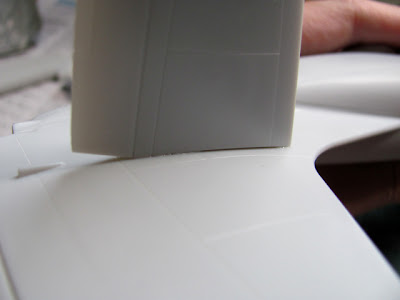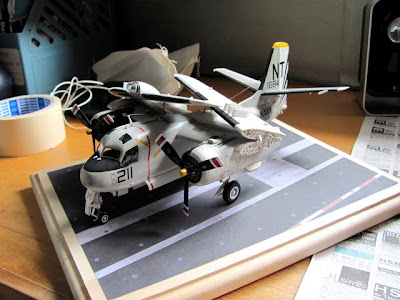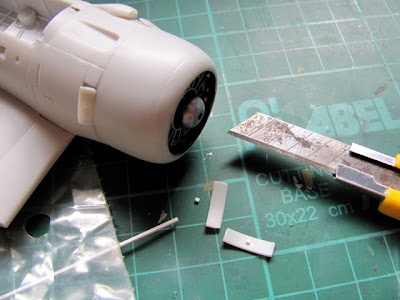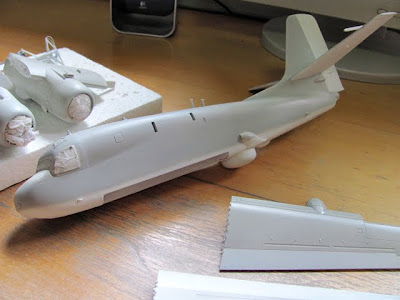This is Part 1 of the Kinetic 1/48 scale S-2E Tracker.

It's a very small plane,and it fits within my A4 sized cutting board.

As you notice in the picture below. The fuselage comes with a lot of panel lines. As with the E-2C Hawkeye, I decided to remove them, as there are no panel lines on the fuselage of the actual aircraft.

Using Tamiya putty, I proceeded to cover up all the panel lines on the fuselage. I left the panel lines on the wings and tail section intact. The panel lines and rivets around the cockpit windows were left alone also. I always enjoy dotting the rivets later on :)


Looks quite messy doesn't it?

Now with the putty dried, I take sanding film of different grades (starting with 400, then 600, then 1000) and progressively start sanding the surface in circular motion. The result is something like below. Note that this process is iterative. If after sanding off, you find that some panel lines are still not covered completely, just repeat the cycle again until it's perfect!

Look ma! No panel lines!

Looking at the aircraft, I knew it was going to be a tail sitter unless considerable weight was added to the nose. The instruction sheet doesn't tell you anything about adding weights to the nose. So those who overlook this step will end up with a tail sitter.
So, to share this with you. This was my (rather stupid) method of adding nose weight. My plan was to get fishing weight. But since I couldn't find any shop selling that, I settled for these artificial rocks wrapped up in blue tac. I got these artificial rocks at an art shop. I thought they might add extra weight as compared to just using blue tac alone. I would find out later that I was wrong. So these next steps is to give advice as to what you
shouldn't do.

I poured the artificial rocks (or pebbles) onto a flattened piece of blue tac, then rolled it up.

Like this...

I stuffed blue tac at every conceivable space I could find.

After adding the weight on one side of the fuselage, I balanced the fuselage with my thump placed at approximately where the main landing gears would be. Since it was tilting towards the nose, I was quite confident that this model would sit properly.

Fuselage halves were glued together and seam lines sanded off.

I didn't spend too much time doing the cockpit. I believed that (like the E-2C) once the model was put together, you can hardly see it. So I roughly hand painted the cockpit.

I didn't bother too much with the instrument panel.


I even stuffed blue tac on the cockpit floor. I regret doing this as you could actually see it from the outside. I should've at least painted them black. Well if anyone asks what those are, just say they're sandbags :)

Next I assembled some other miscellaneous parts like the weapons, refueling boom and search light pod.

I decided to assemble the wings next. The picture below is where the search light pod gets attached to the starboard wing. Here is where I encountered a major fitting problem. Just look at the big gap between the pod and the wing!

So I filled the gap with putty, and once it is semi dry, I took a cotton Q tip, dipped it in Mr Color Thinner, and simply wiped off the access putty. You may have to do this several times, and the results are as shown below. No sanding required.

Before gluing the canopy halves together, remember to spray clear green on the insides of the top rescue hatch window. The instruction sheet doesn't tell to do this. You have to rely on reference pictures. I also hand painted the inside walls of the canopy German gray.

The canopy was then glued onto the fuselage.

Another major fitting problem is where the horizontal stabilizer meets with the fuselage. This one is on the port side. I used the same method as the search light pod to get rid of the gap.

Next I begin masking the canopy windows in preparation for priming. I always cut the masking tape into small strips and mask the outline of the windows first, before masking the insides. I feel that this is more precise.

Masking on windows done, I begin to prime the fuselage with Tamiya fine surface white primer (suitable for both plastic and metal surfaces). I used white primer as the base color will appear richer later. It is also easier to paint the white on the undersides of the aircraft.

The primed surface makes imperfections on the surface very obvious. Here I found that the seam line between the canopy and fuselage wasn't very well sanded. So I did some rework and re-primed again.

The Kinetic kit doesn't come with any parts for the search light. Using photographs as reference, I scratch built these using plastic cards and brass rods. I used aluminum foil as the reflector, I should've just painted it with Super Silver. I hope Kinetic can include parts for the search light in future releases.

Below is the reference photo I used to make the search light.

Next, I begin to assemble the engines. The engine pistons come as one whole piece. No further assembling is necessary. I start by air brushing Mr Color Gloss Black (H2), then air brushing Mr Color Super Silver (H159) over it. Then I do an oil was over it. Make sure the wash goes into all the nooks and crannies.

This is what it looks like close up.

I hand brushed Mr Surfacer 1200 to fill up some annoying gaps on the engine.

Then with a Q tip dipped in Mr Color Thinner...

Wipe off the access, leaving just the putty in the gap. If I were to sand it, I might loose some of the surrounding surface details.
 A bit of dry fitting here to see if the if the wing roots fit into the fuselage.
A bit of dry fitting here to see if the if the wing roots fit into the fuselage. The wing fold mechanism is also treated to an oil wash to bring out the details.
The wing fold mechanism is also treated to an oil wash to bring out the details. The tail section panel lines and rivets are also washed.
The tail section panel lines and rivets are also washed. Wash complete!
Wash complete! Start decal placement.
Start decal placement. I like Kinetic's way of making their wheels. The wheel hub and tires come as separate parts. So you can paint them separately. I first paint the wheel hub white and tires with "Tire Black". Then I glue the wheel hub in place and glue the tire halves together. I then sand away the seam line between the tire halves. After that I roughly cut out round shaped masking tape (pictured below) to cover the wheel hub as I air brush the "Tire Black" onto the sides of the tire after sanding away the seam lines.
I like Kinetic's way of making their wheels. The wheel hub and tires come as separate parts. So you can paint them separately. I first paint the wheel hub white and tires with "Tire Black". Then I glue the wheel hub in place and glue the tire halves together. I then sand away the seam line between the tire halves. After that I roughly cut out round shaped masking tape (pictured below) to cover the wheel hub as I air brush the "Tire Black" onto the sides of the tire after sanding away the seam lines. The wheels are glued to the strut and the landing gear is then glued onto the gear bay beneath the engine.
The wheels are glued to the strut and the landing gear is then glued onto the gear bay beneath the engine. Using red paint, I commence free hand painting of the landing gear door edges.
Using red paint, I commence free hand painting of the landing gear door edges. A bit of the red paint gets "leaked" to the front...
A bit of the red paint gets "leaked" to the front... A bit of light sanding should be able to remove it.
A bit of light sanding should be able to remove it. Decal placement almost complete. I bought the wooden base from an art shop. I will place the model on the wooden base. As you can see now, the model is a tail sitter. All that blue tac and artificial rocks were of no use :(
Decal placement almost complete. I bought the wooden base from an art shop. I will place the model on the wooden base. As you can see now, the model is a tail sitter. All that blue tac and artificial rocks were of no use :(

 Nose landing gear goes in, together with the gear doors. I also complete all the decal placement at this stage.
Nose landing gear goes in, together with the gear doors. I also complete all the decal placement at this stage. I managed to prop the tail up using a clear plastic tubing placed at the back of the model. After decals are dry, I proceed to air brush Flat Clear lightly over the entire model to make the whole thing slightly less glossy.
I managed to prop the tail up using a clear plastic tubing placed at the back of the model. After decals are dry, I proceed to air brush Flat Clear lightly over the entire model to make the whole thing slightly less glossy. Once that's done, the masking tape on the windows are finally removed.
Once that's done, the masking tape on the windows are finally removed. The carrier deck is just a simple printout on A4 paper and pasted onto the wooden base.
The carrier deck is just a simple printout on A4 paper and pasted onto the wooden base. Fishing lines were used to make these antenna wiring.
Fishing lines were used to make these antenna wiring. The model is complete!
The model is complete!


























































